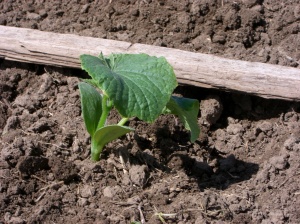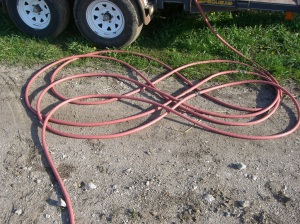I took a day off of work to help during Common Good’s twice-a-week CSA deliveries. They do half of the shares on Monday and the remaining on Thursday each week. A quick timeline:
7:00 start harvest. This week’s offerings were new potatoes (do you know the definition of new potatoes? keep reading), zucchini, cucumbers, eggplant, chard, basil, and tomatoes. Ruth tries not to repeat the same veggies two weeks in a row. She gives recipes as well.
10:00 Ruth begins cleaning and packing while other harvest continues. Heavy items go in the box first.
- Chard is harvested by bending the stalk back where it joins the plant until it cracks, then tearing cleanly off to the side. The goal is to minimize damaged material left on the plant, which encourages rot.
- Zucchinis are harvested with small snips to cut through the stem close to the fruit, taking care not to nick or mark the skin. Once clear of the plant, trim the stem square if needed so there are no angled edges to cut a neighboring fruit in the collection bin. Collected zucchini are dunked in cold water to cool them off.
- Tomatoes are harvested by cupping your hand around the fruit as much as possible to eliminate pressure points. Finger marks can become noticeable bruises on a ripe tomato. CGF harvests every 48 hours. Ones turning even a little red are picked to finish ripening. They are sorted into three bins: ripe, ripening, damaged/slop. Tomatoes ripen from the bottom of the plant up.
- Potatoes are dug up by a potato digger implement pulled by a tractor. A person follows, collecting the potatoes in bins and sometimes picking through dirt clods to find any hidden ones. Once collected they soak in water to loosen the soil.
- Basil is clipped in stems about 6 inches long and bundled 7 to a bunch. The stems are clipped just above a leaf node, to encourage regrowth. Flower buds are ok to include in the cut basil. Tip the collection bin on its side to shade the cut bunches from the sun. Basil turns black if it gets too wet so just give a quick dunk in cold water.
2:00 harvest and packing nearly done. Tomatoes are added to the box last. This week it was 4 pounds worth per box. Place tomatoes stem side down. The weight of a ripe tomato may cause slight pressure marks on the bottom. If the stem side is down, marks there will be cut off anyway when the stem part is cut out. A 2-page newsletter is added to each box. The 37 boxes are loaded into the van for delivery to the drop site.
3:00 depart to drop site. Drop site for Mondays is a private home near East Campus.
3:30 customer pickup. Ruth doesn’t not stay the entire time so most of it is self-serve. Customers transfer the contents of the box to their own bags/boxes. The wax-coated share box returns to the farm for next time. Bin(s) of extra/imperfect veggies are set out for customers to take what they want.
6:30 Ruth collects remaining items such as no-show boxes. They have the option to pick up from the farm but sometimes don’t. In this case they forfeit that week’s vegetables.
Other notes/observations. Only the best produce is kept, quite a bit of culling is done from my untrained eye. The labor to cut up inferior/damaged produce is very time-consuming so the good news is I got free produce! All of the rest goes to the animals. This week I threw all the scraps to the youngest chicken coop. The birds really went for the tomatoes. I saw one pick up a tomato and carry it away from the others so it could eat it all by itself.
Answer: New potatoes are harvested while the plant is still green. The skin of the potato is thinner and more tender. New potatoes can be large or small, depending on the variety.













